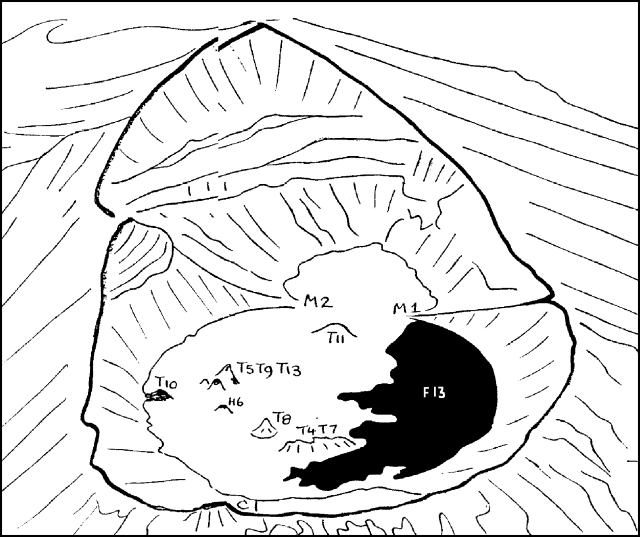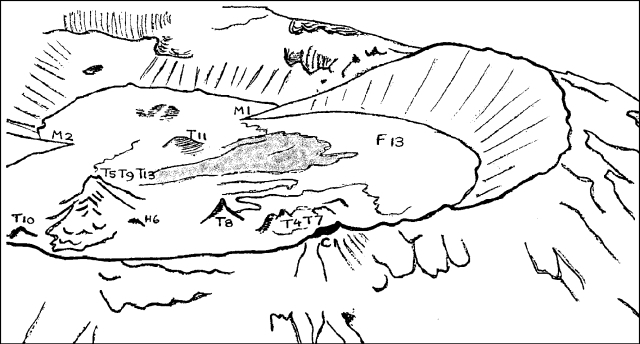Report on Ol Doinyo Lengai (Tanzania) — March 1990
Bulletin of the Global Volcanism Network, vol. 15, no. 3 (March 1990)
Managing Editor: Lindsay McClelland.
Ol Doinyo Lengai (Tanzania) Airphotos suggest continued production of small lava flows on crater floor
Please cite this report as:
Global Volcanism Program, 1990. Report on Ol Doinyo Lengai (Tanzania) (McClelland, L., ed.). Bulletin of the Global Volcanism Network, 15:3. Smithsonian Institution. https://doi.org/10.5479/si.GVP.BGVN199003-222120
Ol Doinyo Lengai
Tanzania
2.764°S, 35.914°E; summit elev. 2962 m
All times are local (unless otherwise noted)
Airphotos taken between 16 and 18 October 1989 by Geoff Price and 7 March 1990 by Lester Eshelman suggest that no large-volume lava flows have been extruded since June 1989. Only minor changes appear to have occurred to cones in the crater since . . . 24 June-1 July and 22-25 November 1988.
During the October 1989 overflight, clouds partially obscured the crater floor, which appeared pale gray, with a slightly darker lava flow (F13), previously seen June-August 1989, near the W wall (figure 14). Cones and vents on the crater floor had changed little since June-August 1989. A vent (T12) seen in September 1989 was no longer visible at the base of the E crater wall. A new vent (T13) had been added to the old complex (T5/T9) which now appeared as several closely spaced cones joined at the base. A possible small hornito (H6) was observed between T5/T9 and T8. The width of the overflow across the former saddle (M2M1) had not changed, but the area of lava S of the saddle may have increased slightly, particularly on the W side of the southern depression.
 |
Figure 14. View of the N crater and southern depression at Ol Doinyo Lengai, looking roughly S between 16 and 18 October, 1989. Traced from a photograph by Geoff Price; courtesy of C. Nyamweru. |
On 7 March 1990, bright sunshine and clear visibility revealed small lava flows of varying colors on the crater floor. However, none were dark gray or black, suggesting that they were of different ages and probably more than a few days (but at most a few weeks) old. No new vents were recognized, and the area of lava in the southern depression had not increased. Flow F13 was white, but had been partially covered by younger brown flows from the W side of T5/T9T13 (figure 15). Many flows of different colors were seen on its W and N slopes, including a narrow white tongue of lava (roughly 4-5 m long and 50 cm wide) stretching from the vent down the flank of the cone complex. Similar features were observed forming on T4/T7 in 1988. Several dark grooves extending from the slopes of T5/T9 appear to be narrow channels formed when a lava flow built levees, restricting it to a narrow stream. The formation of similar features was observed . . . in June and November 1988.
 |
Figure 15. View of the N crater and southern depression at Ol Doinyo Lengai, looking roughly S on 7 March 1990. Traced from a photograph by L. Eshelman; courtesy of C. Nyamweru. |
Notes on individual vents and cones are as follows: T5/T9/T13: Probable center of activity since October 1989, with emission of small thin flows from very small vents, mostly on its W slopes. The top has merged into a single broad cone with several dark patches indicating cracks or vents near the top. T4/T7: Brown and buff colors dominate. Small black patches at the top of two mounds on the E side indicate vents still open. No sign of new material extruded from these vents. Generally smooth and weathered. Lava production from T4/T7 was last reported in November 1988 (13:12). T8: Brown and buff colors dominate. Top of pinnacle appears slightly less steep. No sign of new material. Lava spattering was seen in November 1988, but only gas emission has been observed since then. T10: Gray; part of ridge that joined this cone to the E crater wall may have collapsed. Bubbling lava was seen near T10 in May 1989 (14:06). T11: Pale gray; center of cone is flat and inactive. Possible collapse at N edge. No recent lava emission was apparent and none has been reported since November 1988.
Geological Summary. The symmetrical Ol Doinyo Lengai is the only volcano known to have erupted carbonatite tephras and lavas in historical time. The prominent stratovolcano, known to the Maasai as "The Mountain of God," rises abruptly above the broad plain south of Lake Natron in the Gregory Rift Valley. The cone-building stage ended about 15,000 years ago and was followed by periodic ejection of natrocarbonatitic and nephelinite tephra during the Holocene. Historical eruptions have consisted of smaller tephra ejections and emission of numerous natrocarbonatitic lava flows on the floor of the summit crater and occasionally down the upper flanks. The depth and morphology of the northern crater have changed dramatically during the course of historical eruptions, ranging from steep crater walls about 200 m deep in the mid-20th century to shallow platforms mostly filling the crater. Long-term lava effusion in the summit crater beginning in 1983 had by the turn of the century mostly filled the northern crater; by late 1998 lava had begun overflowing the crater rim.
Information Contacts: C. Nyamweru, Kenyatta Univ.

